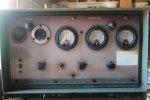I just got my MEP-002A running (nice clean unit that didn't need anything besides filters, oil and a couple of gauges, but I did tear all the sheet metal off and go over everything with a fine tooth comb) and decided to try it on a 3HP air compressor. Same thing as a lot of the previous posts on this thread!
The air compressor is a very compact but heavy duty industrial 3HP, 3phase 208Vac unit from the early 80's (Toshiba Toscon). With the MEP-002A in 208V 3-phase mode, putting out exactly 208Vac at 60 HZ flipping the breaker with the compressor connected pegs the loadmeter and trips the breaker instantly, without the engine bogging down.
By dropping the frequency to 50HZ and the voltage to 190V it will start, and then increasing voltage and frequency to normal the loadmeter sits around 30% with the compressor chugging away. Engine doesn't sound labored at all.
That tells me the breaker in this unit, just like a lot of people have complained, is overly sensitive to motor starting inrush currents. OK, I might just hold out for a good deal on a MEP-803A, but I'm pretty sure I can make this MEP-002A do a little better. Here's some ideas:
R-3 adjustment, which I have not tried, but it seems no one as had much luck with that route.
Add shunt resistance to the low-current side of the breaker (3 resistors in between each pair or six small terminals on the breaker) was thinking of using resistors equal to the breaker's internal resistance across those terminals. That would divert half the current away from the breaker doubling the trip point. Just an idea, not sure if it would work.
Bypass the breaker and run an external breaker (probably the easiest).
Part if the problem is that box with the breaker is very crammed with stuff and not easy to work inside of, and besides I don't want to butcher it. Part of the beauty (at least to me) of these units is the insane complexity and high quality components inside. I could gut that box with the crazy drum switch and the current transformer, wire the 12-lead alternator for 3-phase and use a modern voltage regulator and circuit breaker but it just wouldn't be the same....
I spent about half an hour trying to understand the electrical schematic of this unit (and I'm used to dealing with complicated electrical schematics) and gave up trying to understand it!
What's the opinions on an MEP-803A's ability to deal with 3-phase motor starting? I might just try to get one of those and sell the -002A.
Another (possibly unrelated) question.... What's the black plastic box behind the current transformer to the left in the high voltage box? The field rectifier board is on the right of it. On mine the plastic is cracked in a few places, but it's hard to get a good look at it without pulling stuff apart.



